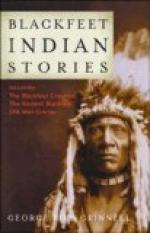The shoots for the arrow shafts were brought into the lodge, peeled, smoothed roughly, tied up in bundles, and hung up to dry. After they were dried, the bundles were taken down and each shaft was smoothed and reduced to a proper thickness by the use of a grooved piece of sand-stone, which acted on the arrow like sandpaper. After they were of the right thickness, they were straightened by bending with the hands, and sometimes with the teeth, and were then passed through a circular hole drilled in a rib, or in a mountain sheep’s horn, which acted in part as a gauge of the size and also as a smoother, for if in passing through the hole the arrow fitted tightly, the shaft received a good polish. The three grooves which always were found in the Blackfeet arrows were made by pushing the shaft through a round hole drilled in a rib, which, however, had one or more projections left on the inside. These projections pressed into the soft wood and made the grooves, which were in every arrow. The feathers were three in number. They were put on with a glue, made by boiling scraps of dried rawhide, and were held in place by wrappings of sinew. The heads of the arrows were made of stone or bone or horn. The flint points were often highly worked and very beautiful, being broken from larger flints by sharp blows of a stone hammer, and after they had been shaped the edges were worked sharp by flaking with an implement of bone or horn. The points made of horn or bone were ground sharp by rubbing on a stone. A notch was cut in the end of the arrow shaft and the shank of the arrow point set in that. The arrow heads were firmly fixed to the shaft by glue and by sinew wrapping.
Although the Blackfeet lived almost altogether on the flesh of birds or animals, yet they had some vegetable food. This was chiefly berries—of which in summer the women collected great quantities and dried them for winter use—and roots, the gathering of which at the proper season of the year occupied much of the time of women and young girls. These roots were unearthed by a long, sharp-pointed stick, called a root digger. Some of the roots were eaten as soon as collected, while others were dried and stored for use in winter.
After they reached the plains, the main food of the Blackfeet was the buffalo, which they killed in large numbers when everything went right. Many of the streams in the Blackfeet country run through wide, deep valleys bordered on either side by cliffs, or broken precipices, falling sharply from the high prairie above. Long ago the Blackfeet must have learned that it was possible to make the buffalo jump over these cliffs, and that in the fall on the rocks below numbers would be killed or crippled. No doubt after this had been practised for a time, there came to some one the idea of building at the foot of such a cliff where the buffalo were run over, a fence which would form a corral or pound, and which would hold all the buffalo that were jumped over the cliff. This corral they called piskun.




